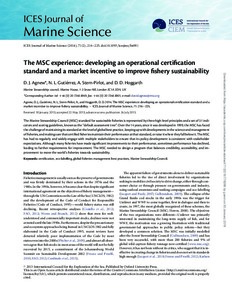| dc.contributor.author | Agnew, D. J. | |
| dc.contributor.author | Gutierrez, N. L. | |
| dc.contributor.author | Stern-Pirlot, A. | |
| dc.contributor.author | Hoggarth, D. D | |
| dc.date.accessioned | 2019-01-30T23:45:21Z | |
| dc.date.available | 2019-01-30T23:45:21Z | |
| dc.date.issued | 2014 | |
| dc.identifier.citation | Agnew, D. J.: Guti´rrez, N. L.: Stern-Pirlot, A. and Hoggarth, D. D. (2014) The MSC experience: developing an operational certification standard and a market incentive to improve fishery sustainability. ICES Journal of Marine Science, 71. pp. 216–225. DOI: 10.1093/icesjms/fst091 | en_US |
| dc.identifier.uri | http://hdl.handle.net/11329/830 | |
| dc.identifier.uri | http://dx.doi.org/10.25607/OBP-385 | |
| dc.description.abstract | The Marine Stewardship Council (MSC) standard for sustainable fisheries is represented by three high-level principles and a set of 31 indicators and scoring guidelines, known as the “default assessment tree”. Over the 14 years, since it was developed in 1999, the MSC has faced
the challenge of maintaining its standard at the level of global best practice, keeping up with developments in the science and management
of fisheries, and making sure that certified fisheries maintain their performance at that standard, or raise it where they fall below it. The MSC
has had to regularly and widely engage with multiple stakeholders to ensure that its policy development is consistent with stakeholder
expectations. Although many fisheries have made significant improvements to their performance, sometimes performance has declined,
leading to further requirements for improvement. The MSC needed to design a program that balances credibility, accessibility, and improvement to move the world’s fisheries towards sustainability | en_US |
| dc.language.iso | en | en_US |
| dc.subject.other | Certification | en_US |
| dc.subject.other | Eco-labelling | en_US |
| dc.subject.other | Global fisheries management | en_US |
| dc.subject.other | Best practices | en_US |
| dc.subject.other | Marine Stewardship Council | en_US |
| dc.title | The MSC experience: developing an operational certification standard and a market incentive to improve fishery sustainability. | en_US |
| dc.type | Journal Contribution | en_US |
| dc.description.notes | Open Access : In article ICESJMS (2014), 71(2), 216-225. doi: 10.1093/icesjms/fst091 the authors have elected to convert the copyright status of the paper to Open Access as a post-production correction. | |
| dc.description.refereed | Refereed | en_US |
| dc.format.pagerange | pp.216-225 | en_US |
| dc.identifier.doi | 10.1093/icesjms/fst091 | |
| dc.subject.parameterDiscipline | Parameter Discipline::Biological oceanography::Fish | en_US |
| dc.subject.parameterDiscipline | Parameter Discipline::Biological oceanography::Biota abundance, biomass and diversity | en_US |
| dc.bibliographicCitation.title | ICES Journal of Marine Science | en_US |
| dc.bibliographicCitation.volume | 71 | en_US |
| dc.description.sdg | 14.4 | en_US |
| dc.description.eov | Fish abundance and distribution | en_US |
| dc.description.bptype | Best Practice | en_US |
| dc.description.bptype | Guide | en_US |
| obps.contact.contactemail | : david.agnew@msc.org | |
| obps.resourceurl.publisher | https://academic.oup.com/icesjms/article/71/2/216/778266 | en_US |
 Repository of community practices in Ocean Research, Applications and Data/Information Management
Repository of community practices in Ocean Research, Applications and Data/Information Management
